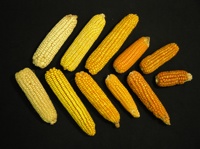Timbuktu Chronicles pointed me to an interesting allAfrica feature on the organic vegetable revolution sweeping around the edges of Cape Town under the leadership of some formidable grandmothers. Great that such a community-based movement is taking off and making a difference, of course. But it was a bit disappointing for me not to see much evidence in the text and photos that indigenous African vegetables are included in the mix. I know there are dedicated people promoting this neglected agrobiodiversity in South Africa. I’ve worked with some of them. Local leafy greens have become mainstream in countries like Kenya in the past few years: you can buy them nicely packaged in supermarkets now, which was certainly not the case when I lived there in the mid-90s. Is that not happening in South Africa? If not, why not? I hope someone out there can tell us.
Can’t stomach golden rice? Get your teeth into golden maize!
![]() Vitamin A deficiency causes eye disease in 40 million children each year and places another 200 million or thereabouts at risk for other health problems. In sub-Saharan Africa and Latin America, between 17% and 30% of children under the age of 5 suffer vitamin A deficiency. Simple solution: give them more vitamin A. But how?
Vitamin A deficiency causes eye disease in 40 million children each year and places another 200 million or thereabouts at risk for other health problems. In sub-Saharan Africa and Latin America, between 17% and 30% of children under the age of 5 suffer vitamin A deficiency. Simple solution: give them more vitamin A. But how?
The poorest regions, which stand to benefit most, often do not have the infrastructure to deliver vitamin supplements, either directly or in fortified foods. Diversifying the diet is dismissed out of hand. 1 So the technical types turn to plant breeding, and in particular the notion of biofortified foods, whereby staple crops are selected to contain higher levels of micronutrients. It was this approach that gave the world Golden Rice, by shifting one of the enzymes in the carotenoid synthesis pathway from daffodil to rice.
An ungrateful world still has not accepted golden rice as the saviour of blind little children, but the technical types have not stopped working. In the latest Science 2 a large team led by Edward Buckler at Cornell University, reports on a different approach to biofortification.

So what other staples are there, preferably ones that might already contain the genes to make vitamin A precursors? Step forward maize, some varieties of which have yellow and even golden orange kernels. It is not enough, however, simply to look at the maize kernels and score them on some scale from pale yellow to deep orange. The reason is that not all carotenoids are created equal. Beta carotene is the precursor of choice, because it contains two of the necessary chemical rings to make vitamin A. Shade of yellow correlates very poorly with total beta-carotene. But all this is detail above and beyond the call of duty. The point is that maize varieties display enormous variability both in total carotenes and in the proportion of beta carotene.
Maize varieties are also hugely genetically diverse. In fact, the differences between two maize varieties is considerably greater than the difference between humans and chimpanzees. Buckler’s group took the known variability in maize kernel colour and asked whether genetic differences were associated with the carotene profile of the variety. They were. The gene for one particular enzyme — lycopene epsilon cyclase — has a large effect on the provitamin A carotenoids.
There’s more in the full paper (which requires a subscription), but one reason that this could be an important result is that it is reasonably easy for others to make use of it. Genetic markers for the favourable versions of the crucial gene make it possible for breeders to look for the potential in any varieties they have that are already adapted to the conditions for which they are breeding. The favourable type is reasonably widespread, so finding parents for crosses should be reasonably easy. Analyzing carotenoid compounds is expensive and difficult, but scoring the target gene is not only about 1000 times cheaper, it is also well within the capabilities of those developing countries that need more vitamin A.
The contrast with Golden Rice couldn’t be greater. That is a proprietary technology that has graciously been made available to those who have the expertise to make use of it. This approach to a nutritionally-improved maize should be much simpler to put to work. Information needed for the DNA analysis is being made freely available, as are inbred maize lines that could make it easier for breeders worldwide. So things look good for biofortified maize, at least technically.
There’s just one remaining little problem — will people eat yellow maize, even if they know it is good for them? Changing human feeding behaviour can be so much harder than changing the food they eat.
Stop press: Prefer wheat to maize or rice? Golden wheat comes a step closer too, with a paper in Euphytica. Italian and Spanish wheat breeders transferred nuclei from wheat into cells from wild barley and from wild wheat relatives. Wheat wild relatives increased the amount of lutein, another carotenoid.
PGR Newsletter published
The latest issue of PGR Newsletter, published by Bioversity International and FAO, is available online. It includes a tribute to Professor Jack Hawkes, a towering figure in the history of agricultural biodiversity, and much else of potential interest.
NOTE: The links on this post were updated on 23 June 2015 to reflect a new arrangement for the hosting of the PGR Newsletter.
Indian biodiversity information
India is to build a national biodiversity information system. Will it include agricultural biodiversity? Not clear from the short article in The Hindu, but I hope to be surprised. The National Bureau of Plant Genetic Resources does have relevant databases (though not all online yet)…